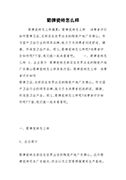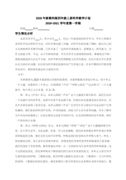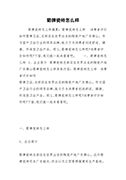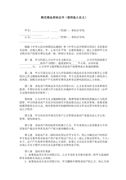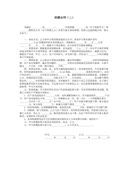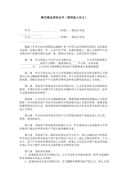小学第6册英语复习第一单元2课时教案(通用2篇)三年级英语教案
小学第6册英语复习第一单元2课时教案(通用2篇)
小学第6册英语复习第一单元2课时教案 篇1
第二课时
教学重点:
有关描述四季特征和表达自己最喜欢季节及原因的语句。
教学难点:
学生仿照read and write中的语篇写作小短文前,教师应先口头示范,并板书关键词和语句结构供学生写作时参考。
课前准备:
资源中心的相关素材。
加拿大四季风光的图片。
read and answer部分录音;活动手册p28—3的录音。
教学过程:
warm up (热身)
活动一 歌曲歌谣
教学参考时间:5分钟
播放第二单元“let’s chant”部分歌谣,全班一齐说唱。
播放歌曲“what’s your favourite season?”,学生吟唱。
教师播放let’s sing部分歌曲“songs of the season”,学生欣赏;请学生说说在歌词中听到的单词,教师讲解歌词大意。
学生跟录音学唱歌曲。
在热身活动中初步回忆第二单元的内容。
活动二 师生谈话
教学参考时间:3分钟
t:what season is it?
s:it’s spring. (板书季节名称)
t:what’s the weather like in spring?
s:it’s windy, but warm. (板书天气特征)
t:what do you wear?
s:sweater / dress / jacket……
t:what can you do in spring?
s:we can go hiking. we can plant trees. we can fly kites…….(板书动词短语)
教师出示其他三个季节的图片,进行类似的对话练习。
在交谈中巩固第二单元的短语和功能结构,为write and say部分内容进行铺垫。
listening and talking (听说练习)
活动三 听力练习
教学参考时间:3分钟
教师播放活动手册p28—3的录音每句话两遍,第一遍学生听,第二遍进行填写。
答案: spring plant trees winter make a snowman
summer swim in the sea fall climb mountains
在听力练习中引出有关最喜欢的季节及在该季节活动的语句,同时巩固单词的拼写。
活动四 小组调查
教学参考时间:4分钟
教师就板书内容对我国的四季特征及人们相应的活动进行综合描述。
教师提问:hello, boys and girls. what’s your favourite season ? why? 请几名学生回答并说出原因。原因可涉及气候、穿着及可在该季节进行的活动。
请学生打开教材第40页,进行pair work,展开问答并填写表格。
学生完成表格后,教师对全班学生的favourite season进行调查,并记录人数。
初步应用所学语言口头表达自己最喜欢的季节和原因,为语篇的阅读和写作做准备。
3、reading and writing (读写练习)
活动五 阅读练习
教学参考时间:10分钟
教师出示加拿大四季风光图片:look, these pictures are about canada. seasons in our country are different from those in canada. what are they like in canada? 启发学生说说图中的季节和天气。
激发学生的阅读兴趣。
学生自己阅读短文,初步了解短文的意思。
教师出示句子:
and it is hard to plant flowers in the rain.
it is so nice to watch the flowers grow.
i also love to watch the leaves fall. is that why we can call autumn “fall”.
they are all beautiful and i can find many things to do.
启发学生理解句子意思;模仿录音朗读,注意适时停顿。
解决学生在理解中的障碍。
跟录音朗读短文。
教师出示句子,学生用yes或no来判断是否与短文内容相符:
mike loves summer. he can swim in the sea. (yes)
in canada, it often snows in spring. (no)
it is so nice to watch the flowers grow in summer. (no)
we can call autumn “fall”. (yes)
it usually snows in winter in beijing. (no)
all the seasons are beautiful. (yes)
检验学生的理解情况。
请学生阅读并回答短文后的两个问题:(教师可以启发学生先画出相关句子,再转换人称进行叙述。)
what can mike do in the four seasons?
in summer, he can swim; in spring, he can plant flowers and watch them grow; in autumn, he can pick apples and watch the leaves fall; in winter, he can ski.
which season does mike like best?
he loves all the seasons. because they are all beautiful and he can find many things to do.
4、consolidation and extension(巩固与扩展)
活动七 练一练
教学参考时间:5分钟
完成活动手册p27—3
学生独立完成排列句子;
教师请几名学生说出答案;
学生根据重排好的句子再进行对话练习。
练习3答案:
which season do you like best?
it is too cold for me.
why do you like winter?
i like winter best.
because i can make a snowman.
i don’t like winter.
how about you?
do you like winter.
练习4答案:
01- 04- 03- 05- 07- 08- 06- 02
活动八 小结
教学参考时间:2分钟
学生朗读read and answer部分短文。
学生将自己写的短文朗读给家人或朋友听。
教学反思:
复习短语过渡到复习句型,由易到难,循序渐进。根据学生喜欢的教学方法,让学生课后自己去调查好朋友喜欢的季节,用采访和总结的方式培养学生用英语来思考的能力
小学第6册英语复习第一单元2课时教案 篇2
第一课时
教学重点:
综合运用第一单元的中心语言,对一天的活动进行有条理的表述。
教学难点:
语篇的叙述和写作是本单元的重点,教师本节课应让学生模仿listen and write部分内容,并同时提供一些语言框架,从而降低学生完成的难度。
课前准备:
资源中心的相关素材。
第一单元动词短语卡片。
学生制作自己的时间表。
录音: listen and write部分;活动手册p25—1。
ask and answer部分两张活动时间表的挂图。
ask and answer部分对话材料复印件。
教学过程:
warm up (热身)
活动一 复习短语
教学参考时间:5分钟
教师播放录音,全班一起说唱第一单元歌曲“weekend”和“let’s chant”部分歌谣。
出示动词短语卡片,教师做动作,请学生猜短语并找出相应的卡片,进行认读,然后师生共同拼读,并板书。
帮助学生回忆第一单元短语,为下面的问答练习充分准备。
活动二 连锁问答
教学参考时间:5分钟
教师先提问一名学生:when do you get up? 该学生回答后,继续用黑板上的其他词组提问下一名学生:when do you … ?,进行连锁问答活动。(教师将学生回答的时间记在黑板的短语后。)
教师将全班分成四大组进行连锁问答比赛,四个组同时进行,教师计时。声音最亮,口齿最清晰,耗时最短的组获胜。(教师提示前后两名学生不能提问同一内容。)
操练句型when do you … ? (i … )at …,为ask and answer部分进行铺垫。
presentation (新课呈现)
活动三 学习短语
教学参考时间:4分钟
(1)教师出示ask and answer部分两张表格的挂图:this is zhang peng’s timetable in a sports camp and this is amy’s timetable in a computer camp. what do they do? 请学生读读表格中的短语。
(2)请学生认读:have computer lesson,play ping-pong,教师要适时通过have english class和play football引导学生理解have computer lesson和play ping-pong的意思。
点击单词recess,学生跟读,讲解中文意思:休息。
初步了解zhang peng和amy的生活安排,认读短语。
活动四 角色扮演
教学参考时间:5分钟
(1)教师发对话材料复印件每人一张。(同桌两个学生一人发材料一,另一人发材料二。)
材料一
amy’s timetable zhang peng’s timetable
time activity time activity
6: 30 a.m. get up get up
6: 50 a.m. eat breakfast eat breakfast
8: 00 a.m. do morning exercise do morning exercise
8: 30 a.m. have computer lesson swim
11: 30 a.m. eat lunch eat lunch
1: 30 p.m. have computer lesson play football
6:30 p.m. eat dinner recess
8: 30 p.m. play computer games play ping-pong
9: 30 p.m. go to bed eat dinner
watch tv
go to bed
材料二
amy’s timetable zhang peng’s timetable
time activity time activity
get up 6: 00 a.m. get up
eat breakfast 6: 30 a.m. eat breakfast
do morning exercise 7: 30 a.m. do morning exercise
have computer lesson 6: 30 a.m. swim
eat lunch 11: 30 a.m. eat lunch
have computer lesson 1: 30 p.m. play football
eat dinner 3:00 p.m. recess
play computer games 4:30 p.m. play ping-pong
go to bed 5: 00 p.m. eat dinner
7: 00 p.m. watch tv
8: 30 p.m. go to bed
(2)学生两人一组分别扮演zhang peng和amy,进行pair work,询问对方的活动时间安排,同时完成表格时间的填写。-
a:when do you … ?
b: at …
教师巡视检查,看学生能否灵活自如的使用第一单元句型完成调查。
在调查活动中进一步应用第一单元所学的功能结构。
exercise (巩固练习)
活动五 听力练习
教学参考时间:3分钟
教师播放listen and write部分录音,学生先听一遍,听第二遍时填写timetable。
从听力、拼写方面检验学生对第一单元内容的掌握情况。
活动六 语篇叙述
教学参考时间:5分钟
将listen and write部分内容提供给学生:
i usually get up at three thirty in the morning. i go to work at four (go to school at … ). i finish my work at about six in the morning ( go home at …). i eat breakfast at seven. then i clean my room. i stay at home in the day. i eat dinner at about seven in the evening. i go to bed at eight. what do i do? i am a street cleaner. 请学生朗读。
参照以上语言框架和学生自己制作的时间表,向全班同学介绍自己一天的作息时间。
训练学生连续表达的能力。
extension 巩固与扩展
活动七 练一练
教学参考时间:6分钟
完成活动手册p25—1
学生自己看图试着说句子;
教师播放录音2遍,学生完成填空。
完成活动手册p26—2
学生自己阅读对话,完成判断题
答案:wu yifan goes to school at 7:30. t
wu yifan’s favorite class is english. f
wu yifan likes playing ping-pong. t
wu yifan has four or five classes every day. f
wu yifan has painting class on the weekend. t
活动八 小结
教学参考时间:2分钟
出示ask and answer部分两张时间表,男生扮演zhang peng,女生扮演amy,进行问答练习——a:when do you … ?
b: at …
活动九 写作练习
(可作为家庭作业)
写一篇主题为“my day”的短文。
五、 板书
教学反思:
本课时学习时先复习时间,用其教师自己的时间表和学生的时间表来做导入。然后引导zhangpen and amy的时刻表上时,让学生练习。作业的布置让学生自己做个类似的的时刻表来巩固学习的内容。
第二课时
教学重点:
有关描述四季特征和表达自己最喜欢季节及原因的语句。
教学难点:
学生仿照read and write中的语篇写作小短文前,教师应先口头示范,并板书关键词和语句结构供学生写作时参考。
课前准备:
资源中心的相关素材。
加拿大四季风光的图片。
read and answer部分录音;活动手册p28—3的录音。
教学过程:
warm up (热身)
活动一 歌曲歌谣
教学参考时间:5分钟
播放第二单元“let’s chant”部分歌谣,全班一齐说唱。
播放歌曲“what’s your favourite season?”,学生吟唱。
教师播放let’s sing部分歌曲“songs of the season”,学生欣赏;请学生说说在歌词中听到的单词,教师讲解歌词大意。
学生跟录音学唱歌曲。
在热身活动中初步回忆第二单元的内容。
活动二 师生谈话
教学参考时间:3分钟
t:what season is it?
s:it’s spring. (板书季节名称)
t:what’s the weather like in spring?
s:it’s windy, but warm. (板书天气特征)
t:what do you wear?
s:sweater / dress / jacket……
t:what can you do in spring?
s:we can go hiking. we can plant trees. we can fly kites…….(板书动词短语)
教师出示其他三个季节的图片,进行类似的对话练习。
在交谈中巩固第二单元的短语和功能结构,为write and say部分内容进行铺垫。
listening and talking (听说练习)
活动三 听力练习
教学参考时间:3分钟
教师播放活动手册p28—3的录音每句话两遍,第一遍学生听,第二遍进行填写。
答案: spring plant trees winter make a snowman
summer swim in the sea fall climb mountains
在听力练习中引出有关最喜欢的季节及在该季节活动的语句,同时巩固单词的拼写。
活动四 小组调查
教学参考时间:4分钟
教师就板书内容对我国的四季特征及人们相应的活动进行综合描述。
教师提问:hello, boys and girls. what’s your favourite season ? why? 请几名学生回答并说出原因。原因可涉及气候、穿着及可在该季节进行的活动。
请学生打开教材第40页,进行pair work,展开问答并填写表格。
学生完成表格后,教师对全班学生的favourite season进行调查,并记录人数。
初步应用所学语言口头表达自己最喜欢的季节和原因,为语篇的阅读和写作做准备。
3、reading and writing (读写练习)
活动五 阅读练习
教学参考时间:10分钟
教师出示加拿大四季风光图片:look, these pictures are about canada. seasons in our country are different from those in canada. what are they like in canada? 启发学生说说图中的季节和天气。
激发学生的阅读兴趣。
学生自己阅读短文,初步了解短文的意思。
教师出示句子:
and it is hard to plant flowers in the rain.
it is so nice to watch the flowers grow.
i also love to watch the leaves fall. is that why we can call autumn “fall”.
they are all beautiful and i can find many things to do.
启发学生理解句子意思;模仿录音朗读,注意适时停顿。
解决学生在理解中的障碍。
跟录音朗读短文。
教师出示句子,学生用yes或no来判断是否与短文内容相符:
mike loves summer. he can swim in the sea. (yes)
in canada, it often snows in spring. (no)
it is so nice to watch the flowers grow in summer. (no)
we can call autumn “fall”. (yes)
it usually snows in winter in beijing. (no)
all the seasons are beautiful. (yes)
检验学生的理解情况。
请学生阅读并回答短文后的两个问题:(教师可以启发学生先画出相关句子,再转换人称进行叙述。)
what can mike do in the four seasons?
in summer, he can swim; in spring, he can plant flowers and watch them grow; in autumn, he can pick apples and watch the leaves fall; in winter, he can ski.
which season does mike like best?
he loves all the seasons. because they are all beautiful and he can find many things to do.
4、consolidation and extension(巩固与扩展)
活动七 练一练
教学参考时间:5分钟
完成活动手册p27—3
学生独立完成排列句子;
教师请几名学生说出答案;
学生根据重排好的句子再进行对话练习。
练习3答案:
which season do you like best?
it is too cold for me.
why do you like winter?
i like winter best.
because i can make a snowman.
i don’t like winter.
how about you?
do you like winter.
练习4答案:
01- 04- 03- 05- 07- 08- 06- 02
活动八 小结
教学参考时间:2分钟
学生朗读read and answer部分短文。
学生将自己写的短文朗读给家人或朋友听。
教学反思:
复习短语过渡到复习句型,由易到难,循序渐进。根据学生喜欢的教学方法,让学生课后自己去调查好朋友喜欢的季节,用采访和总结的方式培养学生用英语来思考的能力
第三课时
教学重点:
问答中外重要节日及部分中外名人的生日所在的月份或季节。
教学难点:
正确表达中外重要节日及部分中外名人的生日所在的月份或季节。
课前准备:
资源中心的相关素材。
12个月的单词卡片。
学生搜集中外重要节日及部分中外名人的生日所在的月份。
教师准备相关节日及部分中外名人的图片或音像资料片。
教师课前准备let’s find out 2的配图画好春、夏、秋、冬四个方框。
录音:listen and number。
教学过程:
warm up (热身)
活动一 复习单词
教学参考时间:3分钟
(1)教师播放let’s chant部分的歌谣,学生听一遍后跟唱。
(2)出示带有各个月份特征的单词卡片。学生看图说出单词,并一起拼读其缩写形式。
帮助学生在有节奏的说唱中巩固记忆单词,为在后面活动中学生能够熟练应用作铺垫。
活动二 复习句子
教学参考时间:5分钟
(1)师生同唱let’s chant部分歌谣“when is your birthday?”。
(2)教师引导学生看歌谣下面的翻滚过山车的动画,师生进行问答,如:when is the rabbit’s birthday? it’s in may. 等。教师示范后请学生进行pair work,也可以展开竞赛的形式进行“连锁问答”。
巩固有关生日问答的语句,为let’s find out 1的活动做准备。
presentation (新知呈现)
活动三 名人生日
教学参考时间:6分钟
(1)请学生分别展示在课前搜集的资料,谈一些名人的事迹;教师鼓励并表扬做得好、知识面广的学生。
(2)教师出示图片和资料简单介绍let’s find out 1中的6个人物,学生阅读资料后,教师提问:when is...’s birthday?学生完成let’s find out 1的表格:(答案)
name birthday
einstein march 14th,1879
madam curie november 7th,1867
thomas edison february 11th,1847
isaac newton january 4th,1643
lu xun september 25th,1881
chen jingrun may 22nd,1933
通过查询一些名人的生日,学习他们的事迹;同时巩固月份单词的拼写。
活动四 中外节日
教学参考时间:5分钟
教师接着刚才的话题,说:einstein’s birthday is in march. march is in spring. so einstein’s birthday is in spring. 师生可进行如下对话:
t:which season is january in?
s:it’s in winter.
教师在课前画好的winter方框里填入january,依次问答其它的月份并板书。
通过生日的话题将月份和季节联系起来,为let’s find out 2的活动做准备。
(2)教师展示各个节日的图片,学生分别说出节日名称。如:展示南瓜灯和孩子们挨家挨户要糖果的场景时,学生做出反应,说:it’s halloween. 教师问:when is halloween?学生回答:it’s in october. 教师说:october is in fall. so halloween is in fall. 板书halloween在fall的方框里。
复习节日名称,找到节日所在的季节,为下面的归类练习进行了铺垫。
(3)学生四人一组,将节日按季节分类,完成下面的表格:
in china in other countries
spring
summer
autumn
winter
(4)每组汇报一项内容,如:there are ...holidays in spring in china. they are ...
3 、let’s play (趣味操练)
活动五 找单词
教学参考时间:3-4分钟
在下面表格中找出12个月单词的缩写,完成下面的练习:
h d j f h d i k n r
i e k a u g a n o q
d c b p e b s m a y
j g f r c h r i j y
u h i w m a r o c t
l x r d g u s k p t
y e j f e b l o s s
t k u j a n t v e x
b l n u z y v w p h
c z e n o v w x t b
________ , _________ , __________ are in spring.
________ , _________ , __________ are in summer.
________ , _________ , __________ are in autumn.
________ , _________ , __________ are in winter.
活动六 站队报数
教学参考时间:3分钟
(1)每次活动5人参加,教师口令:line up! attention,please!
....., you are the first.
...... , you are the last.
...... , stand in front
of .....and behind ....
(2)学生根据教师的口令迅速找到自己的位置,然后报数:i’m the first.(second / third / fourth / fifth)
复习序数词。
4、consolidation and extension (巩固和扩展)
活动七 听力练习
教学参考时间:4分钟
教师播放listen and number录音3遍,第一遍学生听,第二遍排序,第三遍检查。
录音内容如下:
i usually get up early on my birthday. i eat breakfast and go to school. i take candy to my class. after school, i go home and play computer games. it is usually very hot. in the evening, my family goes to the beach. we have a big dinner and eat a birthday cake and ice-cream. then we swim. what season is my birthday in?
活动八 谈生日
教学参考时间:5分钟
(1)请学生朗读listen and number部分排列好的句子。
(2)启发学生模仿listen and write部分内容,从月份、季节和当天的活动等方面说说自己的生日。
活动九 练一练
教学参考时间:5分钟
(1)学生独立完成活动手册p30—10:找出几个人物角色的生日,并填入方格,看谁完成得又快又正确。
(2)两人共同完成活动手册p30—11:
读问题;
商讨答语;
填写答案。
五、板书
recycle 1 (3)
spring: february march april
summer: may june july
autumn: august september october
winter : november december january
(以上单词可以一图片的形式出示)
探究活动
查找资料的探究活动
探究内容:搜集名人的生日和事迹。
探究目的:巩固月份的单词以及日期的表达,了解更多的名人事迹,学习值得敬佩的方面。
探究形式:学生通过上网、或上图书馆查相关的资料
活动过程:
1.生课外查阅更多的名人生日以及他们的事迹。
2.查到的内容讲给大家听,课上互相交流。
小采访的探究活动
探究内容:组织学生进行小型的采访活动
探究目的:培养学生的语言交际能力
探究形式:全体学生
活动特点:此项活动以采访的形式进行。可以同学之间互相采访,也可以指定一部分学生当被采访者,另一部分学生当记者围绕“喜欢什么季节以及原因”的话题进行采访。
活动过程:
1.教师给学生规定需采访的内容:what’s your favourite season? why?
2.教师手拿麦克风,以记者的身份进行自我介绍后,去采访某一个学生。
3.请学生模仿教师的示范,继续进行此活动。
look:beautiful seasons in canada
春季郁金香花争奇斗艳
夏季阳光明媚
秋季枫叶层林尽染
冬季万里雪飘,极具风情
教学反思:
本课时的学习主要是让学生体会成就感,让学生觉得在学习了前几个单元后又收获,能用学过的知识来交流,用学过的知识来应用到实际的生活中。我还扩展了知识,让学生看了加拿大的四季,让学生对四方文化产生好奇和兴趣,这样也提高了学生学习英语的兴趣。


